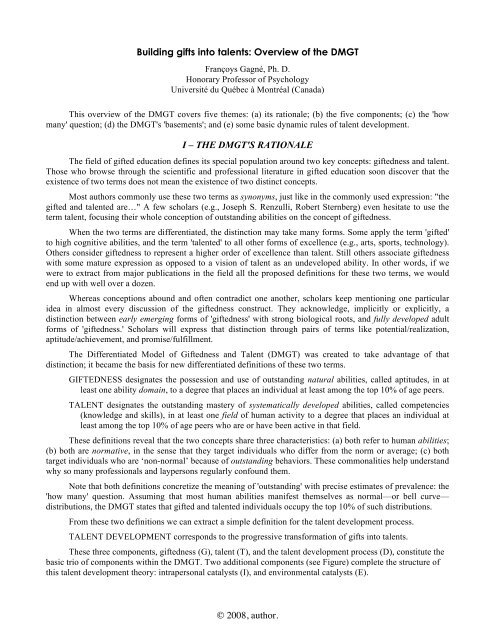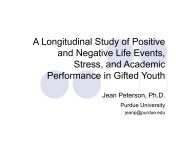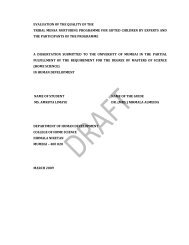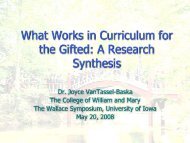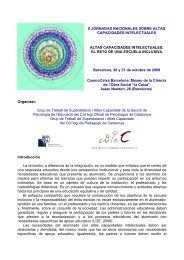Building gifts into talents: Overview of the DMGT - Templetonfellows ...
Building gifts into talents: Overview of the DMGT - Templetonfellows ...
Building gifts into talents: Overview of the DMGT - Templetonfellows ...
Create successful ePaper yourself
Turn your PDF publications into a flip-book with our unique Google optimized e-Paper software.
<strong>Building</strong> <strong>gifts</strong> <strong>into</strong> <strong>talents</strong>: <strong>Overview</strong> <strong>of</strong> <strong>the</strong> <strong>DMGT</strong>Françoys Gagné, Ph. D.Honorary Pr<strong>of</strong>essor <strong>of</strong> PsychologyUniversité du Québec à Montréal (Canada)This overview <strong>of</strong> <strong>the</strong> <strong>DMGT</strong> covers five <strong>the</strong>mes: (a) its rationale; (b) <strong>the</strong> five components; (c) <strong>the</strong> 'howmany' question; (d) <strong>the</strong> <strong>DMGT</strong>'s 'basements'; and (e) some basic dynamic rules <strong>of</strong> talent development.I – THE <strong>DMGT</strong>'S RATIONALEThe field <strong>of</strong> gifted education defines its special population around two key concepts: giftedness and talent.Those who browse through <strong>the</strong> scientific and pr<strong>of</strong>essional literature in gifted education soon discover that <strong>the</strong>existence <strong>of</strong> two terms does not mean <strong>the</strong> existence <strong>of</strong> two distinct concepts.Most authors commonly use <strong>the</strong>se two terms as synonyms, just like in <strong>the</strong> commonly used expression: "<strong>the</strong>gifted and talented are…" A few scholars (e.g., Joseph S. Renzulli, Robert Sternberg) even hesitate to use <strong>the</strong>term talent, focusing <strong>the</strong>ir whole conception <strong>of</strong> outstanding abilities on <strong>the</strong> concept <strong>of</strong> giftedness.When <strong>the</strong> two terms are differentiated, <strong>the</strong> distinction may take many forms. Some apply <strong>the</strong> term 'gifted'to high cognitive abilities, and <strong>the</strong> term 'talented' to all o<strong>the</strong>r forms <strong>of</strong> excellence (e.g., arts, sports, technology).O<strong>the</strong>rs consider giftedness to represent a higher order <strong>of</strong> excellence than talent. Still o<strong>the</strong>rs associate giftednesswith some mature expression as opposed to a vision <strong>of</strong> talent as an undeveloped ability. In o<strong>the</strong>r words, if wewere to extract from major publications in <strong>the</strong> field all <strong>the</strong> proposed definitions for <strong>the</strong>se two terms, we wouldend up with well over a dozen.Whereas conceptions abound and <strong>of</strong>ten contradict one ano<strong>the</strong>r, scholars keep mentioning one particularidea in almost every discussion <strong>of</strong> <strong>the</strong> giftedness construct. They acknowledge, implicitly or explicitly, adistinction between early emerging forms <strong>of</strong> 'giftedness' with strong biological roots, and fully developed adultforms <strong>of</strong> 'giftedness.' Scholars will express that distinction through pairs <strong>of</strong> terms like potential/realization,aptitude/achievement, and promise/fulfillment.The Differentiated Model <strong>of</strong> Giftedness and Talent (<strong>DMGT</strong>) was created to take advantage <strong>of</strong> thatdistinction; it became <strong>the</strong> basis for new differentiated definitions <strong>of</strong> <strong>the</strong>se two terms.GIFTEDNESS designates <strong>the</strong> possession and use <strong>of</strong> outstanding natural abilities, called aptitudes, in atleast one ability domain, to a degree that places an individual at least among <strong>the</strong> top 10% <strong>of</strong> age peers.TALENT designates <strong>the</strong> outstanding mastery <strong>of</strong> systematically developed abilities, called competencies(knowledge and skills), in at least one field <strong>of</strong> human activity to a degree that places an individual atleast among <strong>the</strong> top 10% <strong>of</strong> age peers who are or have been active in that field.These definitions reveal that <strong>the</strong> two concepts share three characteristics: (a) both refer to human abilities;(b) both are normative, in <strong>the</strong> sense that <strong>the</strong>y target individuals who differ from <strong>the</strong> norm or average; (c) bothtarget individuals who are ‘non-normal’ because <strong>of</strong> outstanding behaviors. These commonalities help understandwhy so many pr<strong>of</strong>essionals and laypersons regularly confound <strong>the</strong>m.Note that both definitions concretize <strong>the</strong> meaning <strong>of</strong> 'outstanding' with precise estimates <strong>of</strong> prevalence: <strong>the</strong>'how many' question. Assuming that most human abilities manifest <strong>the</strong>mselves as normal—or bell curve—distributions, <strong>the</strong> <strong>DMGT</strong> states that gifted and talented individuals occupy <strong>the</strong> top 10% <strong>of</strong> such distributions.From <strong>the</strong>se two definitions we can extract a simple definition for <strong>the</strong> talent development process.TALENT DEVELOPMENT corresponds to <strong>the</strong> progressive transformation <strong>of</strong> <strong>gifts</strong> <strong>into</strong> <strong>talents</strong>.These three components, giftedness (G), talent (T), and <strong>the</strong> talent development process (D), constitute <strong>the</strong>basic trio <strong>of</strong> components within <strong>the</strong> <strong>DMGT</strong>. Two additional components (see Figure) complete <strong>the</strong> structure <strong>of</strong>this talent development <strong>the</strong>ory: intrapersonal catalysts (I), and environmental catalysts (E).© 2008, author.
<strong>DMGT</strong> overview 2
Gifts (G)II – THE FIVE COMPONENTS<strong>DMGT</strong> overview 3The G component <strong>of</strong> <strong>the</strong> <strong>DMGT</strong> clusters natural abilities <strong>into</strong> six sub-components. Four <strong>of</strong> <strong>the</strong>m aremental: intellectual (GI), creative (GC), social (GS), and perceptual (GP). The last two are physical abilities:muscular (GM) abilities devoted to large physical movements, and abilities associated with fine motor controland reflexes (GR); both usually contribute to complex physical activities (e.g., tennis, baseball, gymnastics).Natural abilities are NOT innate; <strong>the</strong>y do develop over <strong>the</strong> whole course <strong>of</strong> a person's life, but probablymore during a person's early years. Their spontaneous development through maturational processes, as well asnon-systematic daily activities, is partially controlled by <strong>the</strong> genetic endowment. This development rapidlyproduces large individual differences in a person's aptitudes for <strong>the</strong> systematic development <strong>of</strong> competencies.We can observe natural abilities in most tasks children confront in <strong>the</strong>ir daily activities and <strong>the</strong>irschooling. Think for instance <strong>of</strong> <strong>the</strong> intellectual abilities needed to learn to read, speak a foreign language, orunderstand new ma<strong>the</strong>matical concepts. Think <strong>of</strong> <strong>the</strong> creative abilities involved in writing a short story,composing a song, drawing an attractive poster, or playing with LEGO blocks. Notice also <strong>the</strong> social abilitieschildren use in <strong>the</strong>ir daily interactions with classmates, teachers, and parents. Finally perceptual and physicalnatural abilities guide activities in <strong>the</strong> schoolyard, in neighborhood sports, or arts (dance, sculpture, crafts).Gifts manifest <strong>the</strong>mselves more easily and directly in young children because only limited systematiclearning activities have begun transforming <strong>the</strong>m <strong>into</strong> specific <strong>talents</strong>. Still, we can observe <strong>the</strong>m in olderchildren and adults through <strong>the</strong> facility and speed with which individuals acquire new knowledge and skills. Theeasier or faster <strong>the</strong> learning process, <strong>the</strong> more we will assume <strong>the</strong> presence <strong>of</strong> underlying high natural abilities.Talents (T)Nine talent sub-components appear. Six <strong>of</strong> <strong>the</strong>m correspond to <strong>the</strong> ACT's World-<strong>of</strong>-Work classification <strong>of</strong>occupations. It has its source in John Holland's well-known RIASEC work-related classification <strong>of</strong> personalitytypes: Realistic, Investigative, Artistic, Social, Enterprising, Conventional. The six basic types lead to 26smaller occupational groups summarily identified within each <strong>of</strong> <strong>the</strong> RIASEC categories. Three additional subcomponentscomplement <strong>the</strong> basic World-<strong>of</strong>-Work system: academic (K-12) subjects, games, and sports.Most <strong>talents</strong> are easy to assess: we need only performance measures, nothing else. Exams andstandardized achievement tests cover all K-12 subject matters. Similar assessments exist for mot occupationalfields. It is no doubt in sports that achievements are easiest to assess at levels <strong>of</strong> excellence. Note <strong>the</strong> lack <strong>of</strong>elitism in <strong>the</strong> <strong>DMGT</strong>'s concept <strong>of</strong> talent. Contrary to most scholars, who tend to borrow <strong>the</strong>ir examples fromelite pr<strong>of</strong>essions, <strong>the</strong> <strong>DMGT</strong> stresses <strong>the</strong> presence <strong>of</strong> talented individuals in most human occupations.Talent development process (D)The D component includes three sub-components: activities (DA), progress (DP), and investment (DI).The talent development process begins as soon as a child, adolescent, or adult enters, through identification orselection (DAA), a systematic, talent-oriented and long-term program <strong>of</strong> activities. I judged useful to create aneologism, <strong>the</strong> term talentee, to describe anyone participating in a systematic talent development program.The core <strong>of</strong> <strong>the</strong> talent development activities includes a specific content (DAC), <strong>the</strong> curriculum, <strong>of</strong>feredwithin a specific learning environment (DAF or format). That learning environment may be ei<strong>the</strong>r unstructured(autodidactic learning) or structured (e.g., school, conservatory, sport organization).The progress <strong>of</strong> a talentee from initial access to peak performance can be broken down <strong>into</strong> a series <strong>of</strong>stages (DPS; e.g., novice, advanced, pr<strong>of</strong>icient, expert). Its main quantitative representation is pace (DPP), orhow fast—compared to learning peers—<strong>the</strong> talentee is progressing toward peak achievement. The long-termdevelopmental course <strong>of</strong> a talentee will be marked by a series <strong>of</strong> more or less crucial turning points: beingspotted by a teacher or coach, receiving an important scholarship, accidents, as well as positive (falling in love)or negative (death <strong>of</strong> a close one) personal events impacting <strong>the</strong> developmental process.Finally, <strong>the</strong> investment (DI) sub-component serves to illustrative quantitatively <strong>the</strong> intensity <strong>of</strong> <strong>the</strong> talentdevelopment process in terms <strong>of</strong> time, money, or psychological energy (Ericsson's deliberate practice).
About <strong>the</strong> chance factor<strong>DMGT</strong> overview 5Chance's placement within <strong>the</strong> <strong>DMGT</strong> has evolved considerably over <strong>the</strong> years. First introduced as one <strong>of</strong>five environmental sub-components, it became a qualifier <strong>of</strong> environmental factors. Chance represented <strong>the</strong>degree <strong>of</strong> control that talentees had over environmental influences. Its role broadened when it became clear that<strong>the</strong> problem <strong>of</strong> control also concerned o<strong>the</strong>r <strong>DMGT</strong> components.A famous psychologist in motivation, John William Atkinson, once stated that all humanaccomplishments could be ascribed to two crucial 'rolls <strong>of</strong> <strong>the</strong> dice' over which no individual exerts any personalcontrol: <strong>the</strong> accidents <strong>of</strong> birth and background. Indeed, we do not control <strong>the</strong> genetic endowment received atconception; yet, that genetic endowment affects both our natural abilities (<strong>the</strong> G component), our temperament,as well as o<strong>the</strong>r elements <strong>of</strong> <strong>the</strong> I component. Moreover, we do not control in which family and socialenvironment we are raised. These two impacts alone give a powerful role to chance in sowing <strong>the</strong> bases <strong>of</strong> aperson's talent development possibilities.III – UNDERNEATH THE <strong>DMGT</strong>As mentioned earlier, natural abilities are not innate. They do develop, yet have undeniable geneticunderpinnings. Now that <strong>the</strong> human genome has been decoded, researchers are trying (a) to pinpoint genesresponsible for various human abilities and o<strong>the</strong>r personal characteristics, and (b) to reconstruct <strong>the</strong> biologicalpath between <strong>the</strong>m and observable (phenotypic) characteristics. The <strong>DMGT</strong> represents a 'ground' level <strong>the</strong>ory <strong>of</strong>talent development. Underneath, we will find supporting biological and neurological structures. Theseunderground structures contribute to create large individual differences at 'ground' (behavioral) level.The <strong>DMGT</strong>'s underground can be metaphorically subdivided <strong>into</strong> three basements. At <strong>the</strong> bottom (B-3),we find genotypic structures and processes (e.g., DNA, RNA, protein production). The second basement (B-2)contains a large diversity <strong>of</strong> physiological and neurological processes (called endophenotypes) that control notonly a person's biological development from conception, but also ensure <strong>the</strong> proper functioning <strong>of</strong> body andbrain. The highest basement (B-1) includes anatomical structures (e.g., brain size, tallness, joint flexibility) thathave been associated with abilities and o<strong>the</strong>r personal characteristics. They are called exophenotypes.IV – PREVALENCE AND LEVELSHow many people are gifted and/or talented? The prevalence question is crucial in <strong>the</strong> case <strong>of</strong> normativeconstructs, which, just like giftedness and talent, target a small proportion <strong>of</strong> <strong>the</strong> whole population. Normativeconcepts include poverty, tallness, weight, most neurotic syndromes, and countless o<strong>the</strong>r concepts. Practicallyspeaking, adopting a threshold <strong>of</strong> 10% instead <strong>of</strong> 1%—a tenfold difference in estimated prevalence—has a hugeimpact on selection practices and educational provisions!The 'how many' question has no absolute answer; nowhere will we find a magical number thatautomatically separates those labeled gifted or talented from <strong>the</strong> rest <strong>of</strong> <strong>the</strong> population. The choice <strong>of</strong> anappropriate threshold requires that pr<strong>of</strong>essionals come to a consensus.In <strong>the</strong> <strong>DMGT</strong>, <strong>the</strong> threshold for both <strong>the</strong> giftedness and talent concepts is placed at <strong>the</strong> 90th percentile. Ino<strong>the</strong>r words, those who belong to <strong>the</strong> top 10% <strong>of</strong> <strong>the</strong> relevant reference group in terms <strong>of</strong> natural ability (forgiftedness) or achievement (for talent) deserve <strong>the</strong> relevant label. This generous choice <strong>of</strong> threshold iscounterbalanced by <strong>the</strong> recognition <strong>of</strong> levels or degrees <strong>of</strong> giftedness or talent. There are five hierarchicallystructured levels inspired by <strong>the</strong> metric system; each new level includes <strong>the</strong> top 10% (one decimal place) <strong>of</strong> <strong>the</strong>preceding level. This metric-based (MB) system <strong>of</strong> levels constitutes an intrinsic constituent <strong>of</strong> <strong>the</strong> <strong>DMGT</strong>.Within <strong>the</strong> top 10% <strong>of</strong> “mildly” gifted or talented persons, <strong>the</strong> <strong>DMGT</strong> proposes four progressively moreselective subgroups. They are labeled moderately (top 1%), highly (top 1:1,000), exceptionally (top 1:10,00),and extremely or pr<strong>of</strong>oundly (top 1:100,000).Note that <strong>the</strong> MB system <strong>of</strong> levels applies to every domain <strong>of</strong> giftedness and every field <strong>of</strong> talent. Becausegiftedness domains are not closely correlated, individuals gifted in one domain are not necessarily <strong>the</strong> same asthose gifted in ano<strong>the</strong>r. Consequently, <strong>the</strong> total number <strong>of</strong> gifted and talented individuals largely exceeds <strong>the</strong>10% value. Some studies indicate that it might well be two or three times larger.
<strong>DMGT</strong> overview 6V – THE DYNAMICS OF TALENT DEVELOPMENTBasic dynamic rulesWithin <strong>the</strong> <strong>DMGT</strong>, natural abilities or aptitudes act as <strong>the</strong> “raw material” or <strong>the</strong> constituent elements <strong>of</strong><strong>talents</strong>. It follows from this relationship that talent necessarily implies <strong>the</strong> presence <strong>of</strong> well above averagenatural abilities; in most situations, one cannot become talented without first being gifted, or close to thatthreshold. The reverse is not true: high natural abilities may simply remain <strong>gifts</strong>, and not be translated <strong>into</strong><strong>talents</strong>, as witnessed by <strong>the</strong> phenomenon <strong>of</strong> academic underachievement among intellectually gifted children.There is also a dynamic association between specific <strong>gifts</strong> and <strong>talents</strong>. Because <strong>of</strong> <strong>the</strong>ir status as 'rawmaterials,' <strong>gifts</strong> represent generic abilities that can be molded <strong>into</strong> somewhat divergent skills, depending on <strong>the</strong>field <strong>of</strong> activity adopted by a talentee. For example, manual dexterity, one <strong>of</strong> many natural physical abilities, canbe molded <strong>into</strong> <strong>the</strong> particular skills <strong>of</strong> a pianist, a dentist, a typist, or a video-game player. Similarly, analyticalreasoning, one <strong>of</strong> many cognitive natural abilities, can be molded <strong>into</strong> <strong>the</strong> scientific reasoning <strong>of</strong> a chemist, <strong>the</strong>game analysis <strong>of</strong> a chess player, or <strong>the</strong> strategic planning <strong>of</strong> an athlete.In most talent development situations, <strong>the</strong> four causal components (G, I, E, D) contribute positively to <strong>the</strong>emergence <strong>of</strong> <strong>talents</strong>. And it is assumed that this positive contribution will become more intense as talenteesattempt to reach higher talent goals. These contributions can vary a lot in intensity and continuity from onetalentee's story to ano<strong>the</strong>r. No two developmental paths look alike. This is why talent development is a verycomplex process, a process where <strong>the</strong> four causal components modify <strong>the</strong>ir interactions over <strong>the</strong> course <strong>of</strong> atalentee's developmental path. Think for instance <strong>of</strong> <strong>the</strong> close supervision many parents give to <strong>the</strong>ir children'shomework in elementary school, and its virtual disappearance by <strong>the</strong> time <strong>the</strong> kids reach high school.Illustrative scenariosWithin <strong>the</strong> K-12 educational system, it is not rare to observe academically talented students who haveinvested little more in <strong>the</strong>ir schooling than <strong>the</strong>ir high natural intellectual <strong>gifts</strong>. Most <strong>of</strong> <strong>the</strong>se students never showmuch intrinsic motivation for learning, need almost no environmental support, and invest little time in <strong>the</strong>irschooling beyond presence in <strong>the</strong> classroom and occasional pre-exam 'cramming.' Here are students wholiterally surf on <strong>the</strong>ir intellectual <strong>gifts</strong>.Conversely, a few students with barely above average natural intellectual abilities may reach <strong>the</strong> bottomrung <strong>of</strong> <strong>the</strong> MB system <strong>of</strong> levels—mild academic talent—thanks to intense dedication and effort (IV), longhours <strong>of</strong> deliberate study (DI), and continuous support from both parents and teachers (EI). These two examplesillustrate diverse dynamic interactions between <strong>the</strong> four causal components.What makes a difference?Do some components generally—on average—exercise more powerful influences on talent emergence?My own review <strong>of</strong> <strong>the</strong> existing literature has brought me to propose <strong>the</strong> following downward hierarchy among<strong>the</strong> four components: G, I, D, E. I discuss this hierarchy in detail in some <strong>of</strong> <strong>the</strong> references below (see Gagné,2003, 2005). But, creating a causal hierarchy should not make us forget that in most situations all componentsplay a crucial role in <strong>the</strong> talent developments process. In a nutshell, talent emergence results from a complexchoreography between <strong>the</strong> four causal components, a choreography that is unique to each individual.Suggested readingsGagné, F. (1998). A proposal for subcategories within <strong>the</strong> gifted or talented populations. Gifted Child Quarterly, 42, 87–95.Gagné, F. (2003). Transforming <strong>gifts</strong> <strong>into</strong> <strong>talents</strong>: The <strong>DMGT</strong> as a developmental <strong>the</strong>ory. In N. Colangelo & G. A. Davis(Eds.), Handbook <strong>of</strong> gifted education (3 rd ed.), pp. 60-74. Boston: Allyn and Bacon.Gagné, F. (2005). From <strong>gifts</strong> to <strong>talents</strong>: The <strong>DMGT</strong> as a developmental model. In R. J. Sternberg and J. E. Davidson (Eds.),Conceptions <strong>of</strong> giftedness (2 nd ed.), pp. 98-119. New York: Cambridge University Press.Gagné, F. (in press). The differentiated model <strong>of</strong> giftedness and talent (<strong>DMGT</strong>). In J. S. Renzulli, E. J. Gubbins, K.McMillen, R. D. Eckert, & C. A. Little (Eds.), Systems and models for developing programs for <strong>the</strong> gifted and talented(2 nd ed.). Mansfield Center, CT: Creative Learning Press.


